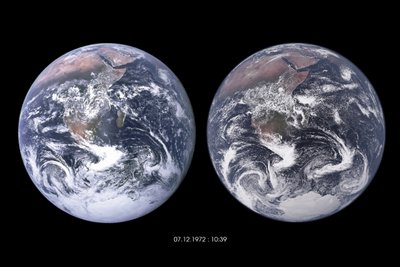Weather and Climate Model ICON published under Open Source License
The ICON Model System

Image source: NASA & MPI-M, DKRZ, NVIDIA
The institutions behind ICON (ICOsahedral Non-hydrostatic modeling framework) and its current developers are the German Climate Computing Center (DKRZ), the German Meteorological Service (DWD), the Karlsruhe Institute of Technology (KIT), the Max Planck Institute for Meteorology (MPI-M), and the Swiss Center for Climate Systems Modeling (Federal Office of Meteorology and Climatology MeteoSwiss and ETH Zurich as C2SM partners). Through the open source release they emphasize their commitment to open science. ICON is the product of a close collaboration between research and the national weather services: the close cooperation results in very efficient weather forecasts and climate projections. Open and transparent scientific tools strengthen the science at a time when society is in critical need of better early warning from natural hazards, and a clearer picture of the changing climate. Making the code publicly available is an important step towards strengthening trust in science and the institutions.
ICON was initially developed jointly by DWD and MPI-M as an atmospheric and weather forecasting model and is now used in Germany and Switzerland for operational weather forecasting. With regard to climate research, the MPI-M has developed further suitable models of other components of the Earth system that allow ICON to be used as a fully coupled climate and Earth system model. In addition to the model component for ocean circulation, there is one for marine biogeochemistry as well as for the land biosphere and hydrological processes. With ICON-ART, KIT has developed a model component that allows the projection of aerosols and atmospheric chemistry and their interaction with the physical state of the atmosphere. Aerosols and the chemical composition determine air quality and also influence solar radiation, clouds and precipitation. The YAC software component required for coupling the submodels was jointly developed by DKRZ and MPI-M and published as open source from the very beginning. To ensure that the simulations can also be used and efficiently calculated on the world's fastest supercomputers, the C2SM partners ETH and MeteoSwiss, together with the MPI-M, DKRZ and DWD, developed an ICON version that can run efficiently on GPUs (Graphics Processing Units).
All submodels are included in the open source release, so that ICON can be used in the most diverse resolutions and configurations to enable a whole range of applications — from global and regional weather forecasts and climate projections to very high-resolution digital twins of the Earth system.
Open Access to Science and Innovation
Making the ICON model code available under an open source license is a major step towards open, transparent, quality-assured and collaborative science. Researchers worldwide will have the opportunity to build on one of the leading models for weather forecasts and climate simulations and work together on future-oriented projects. Commercial use is also possible under the license. The publication takes place in the context of a changing research landscape that promotes increased collaboration and the exchange of knowledge.
“Making the ICON model code available as open source not only helps to intensify cooperation between research and national weather services, but also offers society as a whole the opportunity to benefit from the latest developments in climate and weather research,” says Prof. Roland Potthast, Head of the Meteorological Analysis and Modeling Department at the German Meteorological Service.
The open source release facilitates the integration of ICON into international research collaborations and strengthens Europe’s position in the field of climate and weather research. It also enables a more efficient collaboration with supercomputer vendors, who can test and improve the performance of their hardware using weather and climate models.
Scientific Benefits and Broader Application
Prof. Bjorn Stevens, Director at the Max Planck Institute for Meteorology, says, “The open source release of ICON is a major milestone. Scientifically it is exciting because it will allow us to engage a broader range of expertise to better exploit emerging information technologies. These technologies will help us break down computational barriers, to enable even more detailed and realistic models and open new scientific frontiers — we can pose new types of questions, or answer old questions better.”
The specially developed community interface ComIn, for example, enables scientists to extend the ICON model with their own plug-ins without having to change the complex model code. This not only promotes flexibility in research, but also unleashes the power of innovation within the scientific community.
Corinna Hoose, Professor at the Institute of Meteorology and Climate Research Troposphere Research at KIT, adds, “By providing ICON-ART under open source license, the further development and application of the model for environmental predictions, e.g. of air quality, is simplified and made accessible to a larger scientific and user community. As researchers at KIT, we look forward to working with the other ICON partners, users, and developers from around the world to further improve ICON in the future and expand the model’s potential!”
Further information on the ICON model is available at icon-model.org.
Contact
Dr. Daniel Klocke
Computational Infrastructure and Model Development
Max Planck Institute for Meteorology
daniel.klocke@mpimet.mpg.de
Prof. Dr. Bjorn Stevens
Director
Max Planck Institute for Meteorology
bjorn.stevens@mpimet.mpg.de
